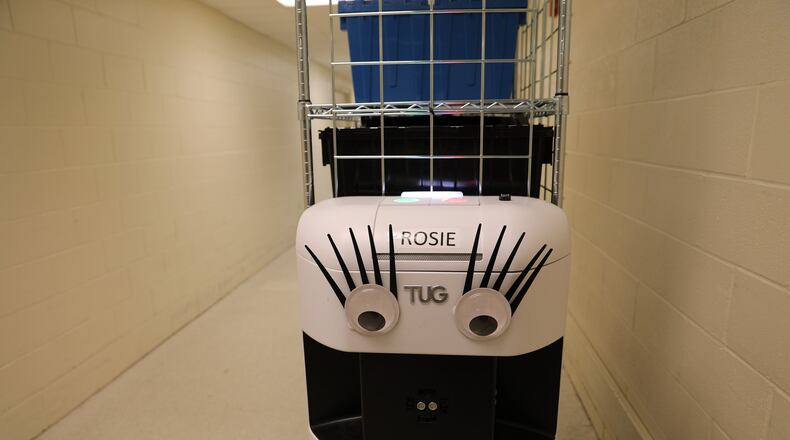Kroger Co.
The Kroger Co. and Microsoft Corp. in January announced they are partnering on a smart technology system in stores in Monroe, Ohio, and in Redmond, Wash.
EDGE Shelf uses digital displays to indicate prices, promotions and other information. Consumers can use their smart phone or hand-held devices available in the store to find items on their shopping list and to get coupons that target their interests.
RELATED: Ready to work with a smart robot? Some Dayton workers already are
Kroger also has screens and cameras on end shelves that identify a customer’s gender and age and display an advertisement that targets them, said Erin Rolfes, corporate affairs manager for Kroger.
Credit: DaytonDailyNews
“We are always willing to engage with technology in our stores and make the customer shopping experience a little bit easier,” Rolfes said.
RELATED: Kroger to roll out digital aisle displays that connect to smartphones
Brittain Ladd, a Dallas-based grocery industry analyst, said all major grocers are adopting AI technology for competitive reasons. He said they gathered customer data for years through shopping cards and at the cash register. Now they gather additional information with in-store technology and apps downloaded by customers. They use that data to determine patterns of consumer behavior and target consumers with personalized content.
He said some stores have cameras that watch a customer’s face to see if he or she is happy or frustrated and they use that to determine what the customer might want.
“Make no mistake. Every time you step inside a grocery store you are being followed in that store,” Ladd said. “There are cameras. There are computers. There is software. There are robots and they are all tracking you to learn as much as they can.”
PHOTOS: Robots and grocery shopping - artificial intelligence in action
Hospitals
Kettering Health Network uses AI in a variety of ways, spokeswoman Elizabeth Long said. Robots deliver materials at both Kettering and Soin medical centers. AI technology is also in use at the network's new centralized command center, which uses integrated software to track patient transfers through the system from admission to discharge. The software then automatically places the patient's room on a list to be cleaned.
The health network also uses AI to analyze CT scans of stroke patients to quickly assess if the patient is a candidate for surgery. The final decision is made by the stroke team, according to a news release. AI is also used in the network’s NeuroRehab and Balance Center.
Ben Sutherly, spokesman for Premier Health, said AI “promises to enhance analytics and clinical decision-making.”
RELATED: These top 5 companies drive Dayton-area economy. Are they ready for the future?
Premier is “using AI to support physicians in their clinical documentation. Such technology is being used in a supporting role, and is not intended to supplant a care provider’s judgment. We are closely monitoring and evaluating other AI technologies as well,” Sutherly said.
Technology companies
Evanhoe & Associates Inc., a Riverside information technology solutions company, is doing a supply chain risk project for the U.S. Air Force.
“By using AI the Air Force plans to be able to anticipate shortages, be ahead of it and analyze supplier weaknesses,” President Chuck Evanhoe said.
RELATED: Navy awards multi-million dollar contract to two Dayton area firms
Mile Two, a Dayton software and technology solutions company, is researching human-machine teaming, said Jeff Graley, president and co-founder. The company researches the capabilities of AI and how customers can use the technology and then develops the software to do it.
What AI allows “organizations to do is to engage with their data in ways that are beyond the typical human skill,” Graley said.
LexisNexis Legal and Professional
LexisNexis Legal and Professional in Miami Twp. uses artificial intelligence technology like machine learning, deep learning and natural language processing to create powerful analytical tools for attorneys and others in the legal industry.
That includes helping users better understand how judges think and rule, Chief Technology Officer Jeff Reihl said.
“We are combining the latest AI technology, with our human generated metadata, guided by expert attorneys and data scientists, to continue to advance the state of the art with legal analytics,” Reihl said. “Investments in all aspects of AI will continue to ramp-up, especially in data rich companies and industries. You will see continued, evolutionary improvements.”
RELATED: Meet the 66 top employers in the Dayton region. How big are they?
Yaskawa America Inc.’s Motoman Robotics Division
Robots built at Yaskawa America Inc.’s Motoman Robotics Division in Miamisburg can be paired with AI technology to do a variety of jobs, such as high-volume clinical laboratory processes or picking objects randomly placed in a bin and loading them into a machine or container, said Dean Elkins, segment leader for material handling.
Credit: HANDOUT
Credit: HANDOUT
Adding the technology to the company’s robots give them machine vision, touch feedback and the ability to process huge quantities of data that help customers improve their processes and efficiency, he said.
RELATED: Sinclair, Motoman partner on robotics training
The company’s “collaborative robots” work in coordination with a human employee to do tasks, he said. For example a worker may use the robot to handle portions of loads that are very heavy or to place a part into a dangerous place.
“I like to call them steel-collar workers,” Elkins said.
University of Dayton
The University of Dayton Vision Lab used AI to research ways to find intrusions, such as construction, on oil and gas pipelines, said Vijayan Asari, an electrical and computer engineering professor and lab director.
Pipeline companies gather huge amounts of data using aircraft and other means on 2 million miles of pipeline, he said. The automated system developed by the lab uses the data to look for and immediately report intrusions more quickly than a human could. The lab is now applying AI to find pipeline leaks.
In a defense-related project, the lab uses AI to detect and distinguish whether an object a mile away is a human or an animal.
Credit: HANDOUT
Credit: HANDOUT
The lab also is working on a project using AI in medical diagnosis, Asari said.
“Lots of progress is happening in this area for all kinds of applications in every walk of life,” he said. “Our capabilities will be enhanced.”
MORE TO THIS STORY: What are the challenges and promises of artificial intelligence?
PHOTOS: Robots and grocery shopping - artificial intelligence in action
Facebook Live - Are the robots coming for your job?
How the next recession could affect Dayton
Trucking industry must overcome challenges to continue growth
Ohio’s fee amnesty for suspended drivers has started but only lasts six months
What to do to land your dream job
See where millions have been spent to improve downtown Dayton
About the Author





